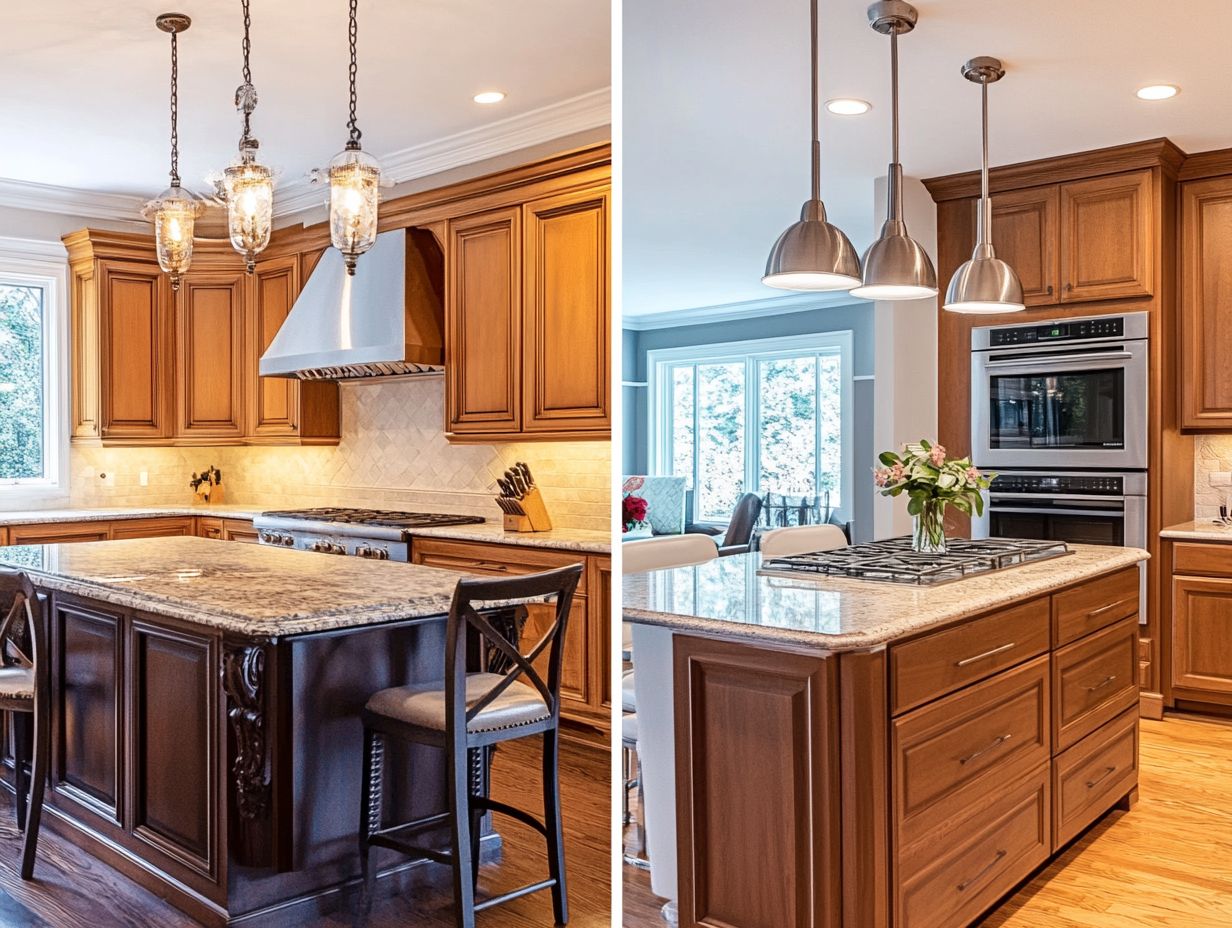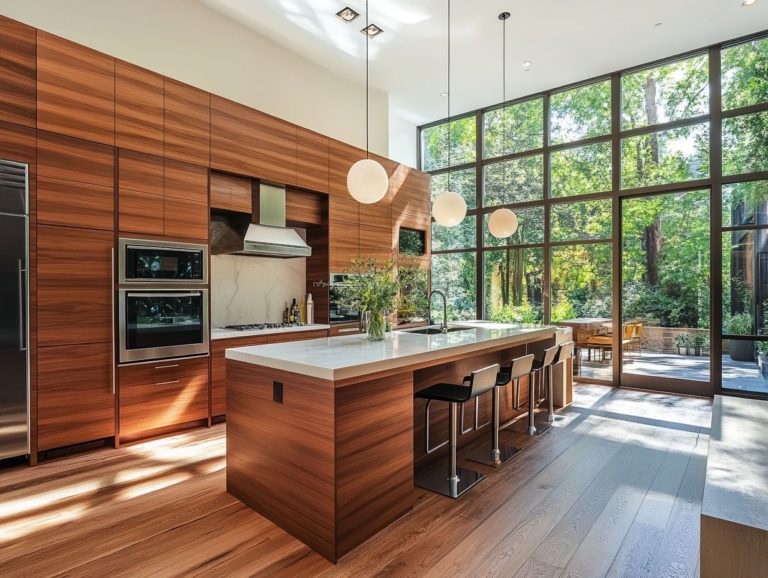Exploring Traditional vs. Contemporary Kitchen Layouts
A well-designed kitchen goes beyond just being functional; it serves as the heart of your home, where cherished memories are crafted.
This article delves into the distinctions between traditional and contemporary kitchen layouts, illuminating their unique features, advantages, and drawbacks.
Whether you find yourself drawn to the timeless allure of a classic kitchen or the smooth, modern lines of contemporary design, understanding your options is essential.
Choose a kitchen layout based on your preferences, lifestyle, and budget.
Contents
- Key Takeaways:
- The Importance of a Well-Designed Kitchen
- Traditional Kitchen Layouts
- Contemporary Kitchen Layouts
- Factors to Consider when Choosing a Kitchen Layout
- Frequently Asked Questions
- What is a traditional kitchen layout?
- What is a contemporary kitchen layout?
- What are the main differences between traditional and contemporary kitchen layouts?
- Which kitchen layout is better for smaller spaces?
- Can traditional and contemporary kitchen layouts be combined?
- How do I decide which kitchen layout is right for me?
Key Takeaways:

Traditional kitchen layouts offer a classic and timeless design but may lack modern conveniences and storage space.
Contemporary kitchen layouts prioritize functionality and efficiency with sleek designs and advanced appliances, but may not suit all personal preferences and lifestyles.
When choosing a kitchen layout, consider your personal preferences, lifestyle, functionality needs, and budget to find the best fit for your home.
The Importance of a Well-Designed Kitchen
A well-designed kitchen is the heart of your home. It creates a space that encourages family gatherings and enriches the aesthetic appeal.
Thoughtfully integrating design elements can transform your kitchen into an inviting and organized space. Clean lines, natural materials, and unique features reflect your personality while fulfilling practical needs.
This enhances not only your cooking experience but also fosters a warm ambiance with a timeless charm that resonates with everyone who steps inside.
The style you choose—whether it’s modern, farmhouse, or Mediterranean—plays a crucial role in shaping the overall vibe of the space. Textured surfaces, like reclaimed wood or polished stone, can add personality and warmth to your kitchen. Sleek stainless steel appliances bring utility and elegance.
Clever storage solutions, such as pull-out shelves and hidden compartments, optimize functionality while keeping the atmosphere clutter-free. This allows your kitchen to shine as a welcoming hub for friends and family.
These design choices enhance both utility and beauty in your kitchen, creating a harmonious balance that inspires creativity and connection.
Traditional Kitchen Layouts
Traditional kitchens feel warm and inviting. They prioritize comfort and functionality, often showcasing rich textures and classic elements.
Imagine cabinetry styles adorned with intricate details and decorative lighting, all working together to foster a cozy ambiance that encourages both conversation and culinary creativity.
Features like crown molding and an expansive layout enhance the elegance of the space, making traditional kitchens a favored choice for those who appreciate both beauty and practicality.
Features and Characteristics
Traditional kitchens feature elegant design elements. These include rich cabinetry, decorative touches, and a cozy atmosphere that invites family gatherings.
Your cabinetry styles typically showcase classic aesthetics, often crafted from solid woods like oak or cherry. These choices provide durability while exuding warmth.
With intricate carvings and finishes that reflect artisanal craftsmanship, your cabinets serve as both practical storage solutions and stunning focal points in the space.
To complement your cabinetry, decorative details, such as crown molding, add a touch of sophistication, elegantly framing the upper cabinets and enhancing the overall height of the kitchen.
Common materials like granite or marble countertops harmonize beautifully with these elements, contributing not only to the kitchen’s visual appeal but also to its functionality, making meal preparation seamless and enjoyable.
Pros and Cons

When you’re contemplating a traditional kitchen layout, it’s crucial to weigh the pros and cons. These kitchens exude a timeless charm and a cozy ambiance, but they can also present challenges regarding functionality and renovation.
Imagine the warm tones of wood cabinetry, classic tile backsplashes, and intricate molding details coming together to create an inviting space that feels both welcoming and elegant. This style fosters a sense of family gathering and connection—a vibe that’s often hard to replicate in more modern designs.
However, maintaining those ornate features can require significant upkeep. The layout might not always embrace the latest technologies that enhance cooking efficiency. Traditional kitchens can sometimes feel a bit cramped, especially in smaller homes, limiting access to modern conveniences.
Contemporary Kitchen Layouts
Contemporary kitchen layouts burst with vibrant natural materials, showcasing sleek finishes, open spaces, and a strong focus on functionality—qualities that today’s discerning homeowners find irresistible.
These kitchens seamlessly integrate innovative features like quartz countertops and built-in appliances, creating a stylish, organized environment that embraces minimalist aesthetics while celebrating dynamic design.
Features and Characteristics
The features and characteristics of contemporary kitchen layouts revolve around dynamic design and clean lines. Unique materials and innovative elements elevate both functionality and aesthetics.
With a focus on sleek cabinetry styles, your kitchen can feature flat-panel doors or minimalist shaker designs. This offers a seamless appearance that emphasizes organization.
The strategic use of warm wood accents introduces a touch of nature indoors. Sophisticated color palettes foster a calming atmosphere.
Integrating advanced kitchen appliances, like built-in refrigerators and stovetops that heat pots directly with electromagnetic energy, not only saves space but also contributes to a streamlined look, ensuring that everything has its designated spot.
Collectively, these elements create an organized environment that is as stylish as it is practical, effortlessly bridging the gap between modern convenience and timeless beauty.
Pros and Cons
While contemporary kitchens are celebrated for their sleek finishes and modern aesthetics, it’s essential to weigh the pros and cons, especially regarding functionality and the scope of your kitchen renovation.
The versatile designs cater to various cooking styles and preferences, granting you the freedom to customize layouts that enhance your workflow and efficiency. The diverse array of materials and colors available in contemporary designs adds sophistication to your home, making it an attractive option for those looking to craft a stylish culinary space.
However, with this aesthetic appeal comes the challenge of maintenance; high-gloss surfaces showcase fingerprints, and certain materials may require specialized cleaning. You might also encounter design limitations when trying to balance open space with necessary storage, ultimately affecting your kitchen’s functionality.
Factors to Consider when Choosing a Kitchen Layout

Selecting the ideal kitchen layout is a pivotal decision that requires careful consideration of multiple factors. Reflect on your personal preferences and functionality, ensuring the design accommodates your lifestyle needs.
It’s important to consider your budget and space constraints, creating a harmonious balance between style and practicality.
Your dream kitchen awaits—don’t wait to find the perfect layout that fits your lifestyle!
Personal Preferences and Lifestyle
Your personal preferences and lifestyle shape your kitchen design choices. You likely want layouts that create inviting spaces for family gatherings and reflect your unique style.
How you live influences your decisions. You might prefer open layouts for seamless interaction or traditional designs that evoke warmth.
If you have young children, you may prioritize durable materials and easy-to-clean surfaces. Those who enjoy entertaining might look for spacious islands and multifunctional areas.
Ultimately, your kitchen’s personality reflects who you are, mixing your habits, values, and style into a cohesive design.
Functionality and Efficiency
Functionality and efficiency are essential in kitchen design. They ensure the space meets your cooking and entertaining needs while showcasing innovative features.
Carefully consider the layout, as it significantly affects how appliances and cabinetry work together. A well-planned layout facilitates smooth movement between cooking, cleaning, and meal preparation, optimizing workflow.
Incorporating smart storage solutions, like pull-out shelves and vertical cabinetry, maximizes space while keeping essentials accessible.
A thoughtfully designed kitchen enhances usability and adds sophistication, inviting everyone to enjoy culinary experiences.
Budget and Space Constraints
Budget and space constraints shape your kitchen design journey. They guide your selections of materials, features, and layouts that fit your financial and spatial realities.
As you navigate renovations, weigh high-end materials against cost-effective options. Choices about cabinetry, countertops, and flooring impact both appearance and functionality.
Homeowners often opt for versatile designs that maximize square footage. Every inch should serve a purpose, whether through clever storage or open layouts.
By prioritizing these elements within your budget, you can create a stylish and practical space. Thoughtful planning leads to remarkable transformations.
Frequently Asked Questions

What is a traditional kitchen layout?
A traditional kitchen layout usually has a U or L shape, focusing on symmetry and separate workspaces for cooking, cleaning, and food prep. It features ornate designs and neutral colors.
What is a contemporary kitchen layout?
A contemporary kitchen is more open and fluid, emphasizing functionality. It often includes an island for additional workspace and uses modern designs and bold colors.
What are the main differences between traditional and contemporary kitchen layouts?
The main differences are in design and aesthetics. Traditional layouts are ornate and symmetrical, while contemporary ones are minimalistic and open.
Which kitchen layout is better for smaller spaces?
Contemporary layouts are more space-efficient, working well in smaller areas. They often use multifunctional elements to maximize space.
Can traditional and contemporary kitchen layouts be combined?
Yes, you can mix traditional and contemporary elements. This creates a unique design that combines the best of both styles. Careful consideration is needed to maintain a cohesive look.
Explore more tips for your kitchen design or contact us for a consultation!
How do I decide which kitchen layout is right for me?
Choosing the right kitchen layout can be exciting! Think about your personal style and how you want your kitchen to look and feel.
Also, consider how you will use the space. Is it for family gatherings, or just for cooking?
The best layout is the one that suits your needs and brings you joy every day!





